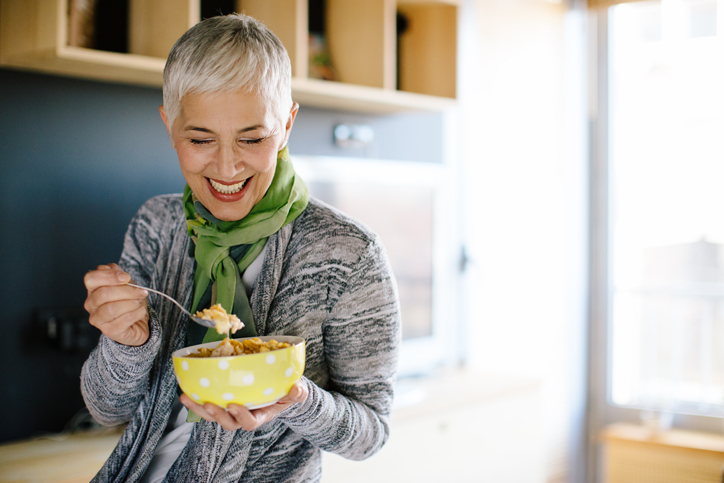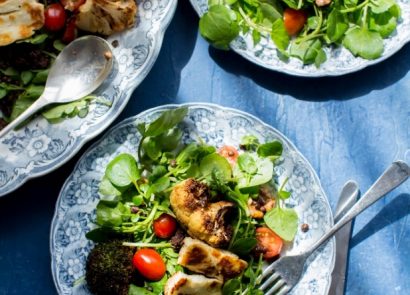You know the drill. Smooth-running mornings and busy households don’t exactly go hand in hand, especially when you’ve got the kids’ packed lunches to deal with and your first Zoom meeting is in t-minus three minutes. Add the emotional labour of having to think about what’ll best set you up for the day and before you know it, a bowl of measly cereal for breakfast will just have to do, leaving you unsatisfied and hungry for more. The good news is, creating a healthy breakfast needn’t be complex – or time-consuming, for that matter. Take it away, experts…
Time oat
Much like the number you see on all food packaging – i.e calories – not all breakfast cereals are created equal and they can’t just be lumped into the same group when talking about nutritional benefits. You don’t need us to tell you that a high-fibre, natural granola would beat a sugary cereal in a nutritional show-down, but when it comes to choosing a packet from the supermarket shelf, there are a few more fundamentals to consider. “The benefits of cereals and granolas depend on their composition, so while some are nutritious, others are not very healthy breakfast options,” notes Dr Greg Potter, chief science officer at Resilient Nutrition (resilientnutrition.com). Without getting too technical, a granola made with oats, for example, contain a type of soluble fibre called beta-glucan that help to lower blood cholesterol and keep blood sugar levels stable – all of which your doctor would give you the thumbs up for. The problem, however, lies with the sugar that’s added to a lot of shop-bought granolas, says Dr Potter. “Granolas rich in date syrup or cane juice and poor-quality fats are likely to lead to greater bloodsugar swings and less healthy blood lipids which, over time, could increase risk of cardiometabolic diseases such as diabetes.”
Fuelling fodder
Alternatives for a healthy breakfast can come in many forms, but the star of the show is protein. Why? Well, protein keeps you fuller for longer, controls blood-sugar regulation and helps you to build muscle mass. Complex carbohydrates should also play a role, along with vegetables to keep you nourished throughout the morning, suggests nutritionist Jenna Hope (jennahopenutrition.com). “Scrambled eggs on sourdough toast with a side of spinach would be a perfect way to start the day. Eggs are high in protein, B-vitamins and choline to support cognitive function, and spinach is rich in vitamin K and calcium to promote bone health. My choice of sourdough bread would be Bertinet Bakery because it contains fibre and live cultures to ensure the presence of beneficial bacteria in the gut.” Scrambled tofu will also fit the bill if you eat a plant-based diet, FYI and if you fancy something a little bit sweeter? Porridge made with whole milk topped with cinnamon and berries can help you get the right balance of macronutrients.
May contain nuts
For those wondering, the answer is no, you don’t have to completely forgo your bowl of granola if that’s what you enjoy. What’s more, there are ways to bolster its health and nutrition benefits. “If you’re opting for granola for breakfast, look for one which is low in sugar (less than 5g of sugar per 100g) and low in saturated fats (less than 1.5g per 100g),” Jenna recommends. “Additionally, try to find one which is packed with a variety of wholefoods, nuts and seeds to provide omega 3.” Pairing your granola with a source of protein, such as whole milk or natural Greek yoghurt and berries for extra phytonutrients can be classed as a brilliant bowlful. And, while scanning the ingredients on the packet may seem a bit arduous, it might just help you make a more informed choice about what you’re spooning in your mouth. Anything else to note? “Bear in mind that the sequence of the ingredients reflects their proportions and whatever is listed first is the most abundant ingredient,” says Dr Potter. He recommends checking for the presence of tree nuts, such as almonds and hazelnuts, whole oats, multiple types of added fruits or vegetables, no or minimal added sources of sugar, including cane, grape, date and agave juices and syrups, at least 10 percent protein and 10 percent fibre.
Sizing up
Now you’ve got to grips with the ingredients to look out for on a granola box and what belongs in your bowl, let’s talk portion sizes. It’s important to recognise that granolas can be typically high in calories, but that doesn’t mean they’re necessarily unhealthy. Like Dr Potter says: “it’s fine to include products rich in primarily monounsaturated fats” in your breakfast, and granolas containing foods like nuts and seeds are naturally higher in calories, as well as a range of micronutrients. “Portion size is key and any meal has the potential to be higher in energy than what would be recommended,” states Jenna. Per 50g, she recommends a granola that contains less than 2.5g of sugar, but because those higher in nuts and seeds are more likely to keep you fuller for longer, you may find that 30 or 40g will suffice. In essence, we all know that it’s easy to overdo it on the cereal – Tony the Tiger wasn’t famous for his fibre-rich flakes, after all – but try not to get too hung up on the numbers. The upshot? As long as you’re keeping your breakfast simple and focused on grains, nuts, fruits and vegetables, you’re more likely to get a slower release of energy and fuelled for longer. Now? Turn the page for some recipes that are worth waking up for.





















